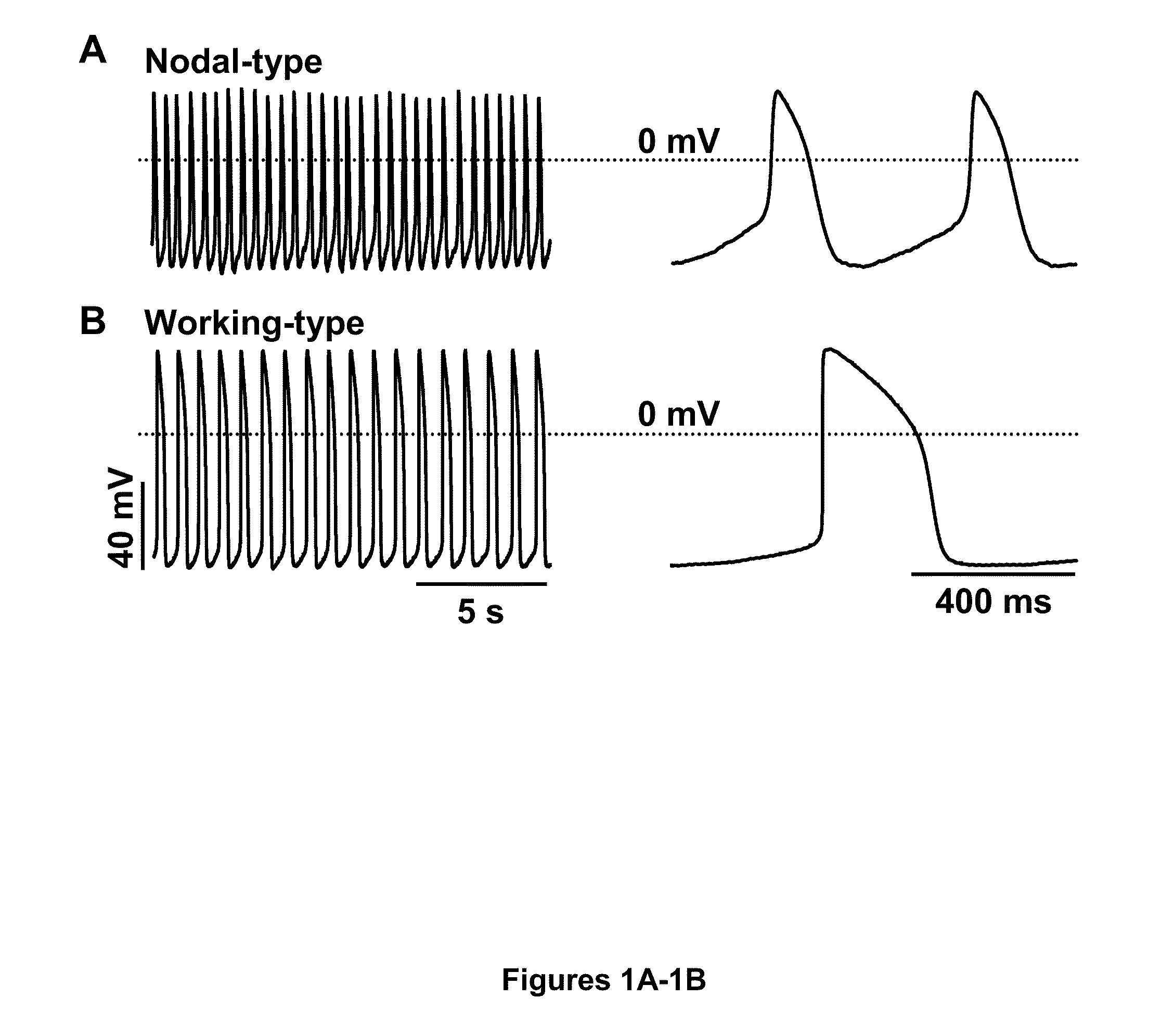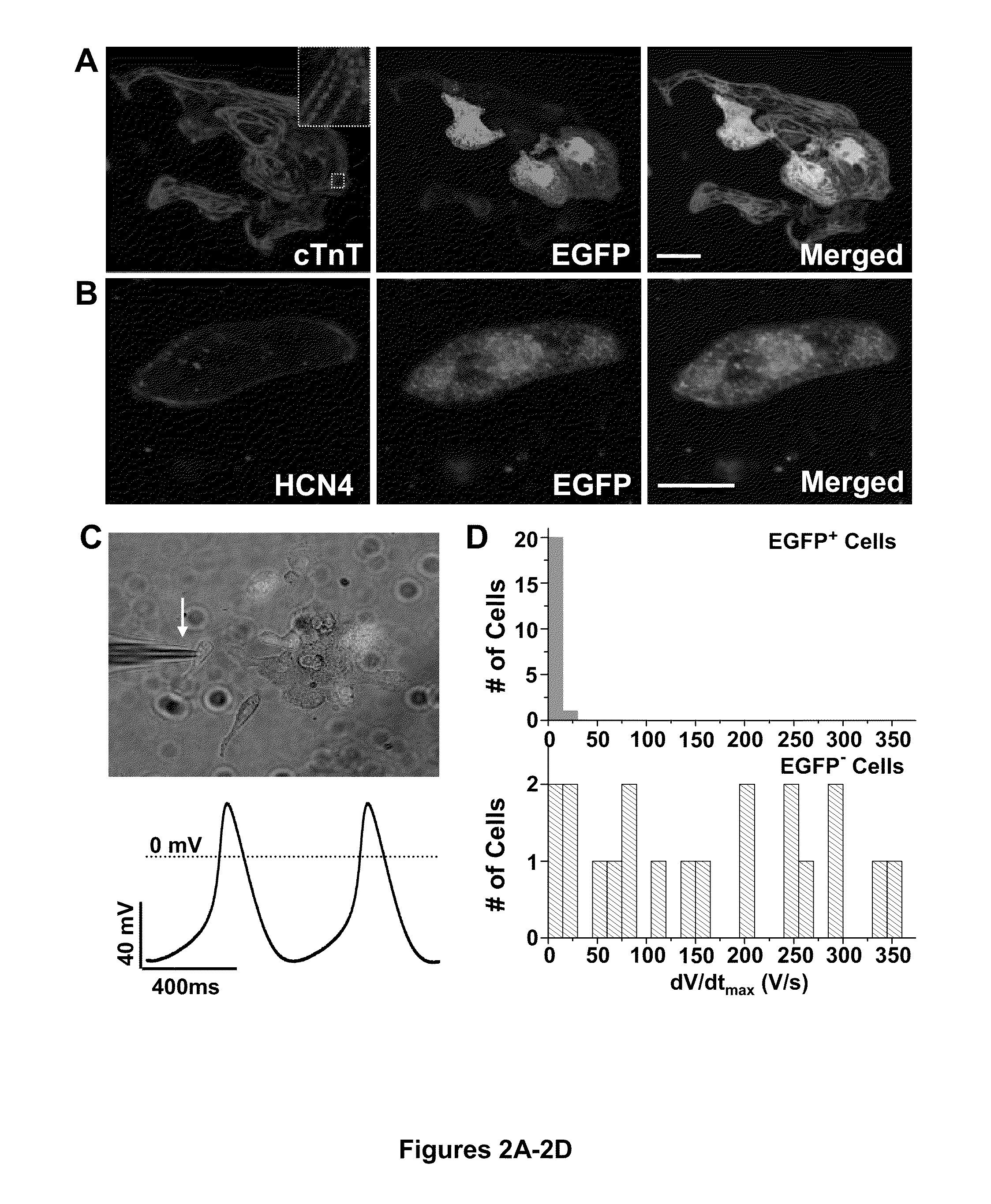Induction of human embryonic stem cell derived cardiac pacemaker or chamber-type cardiomyocytes by manipulation of neuregulin signaling
a human embryonic stem cell and signaling technology, applied in the direction of genetically modified cells, skeletal/connective tissue cells, drug compositions, etc., can solve the problems of limited choice, increased susceptibility to infection, and limited battery life, so as to improve cardiac tissue repair or cardiac organ function, and tremendously improve the effect of reversing serious cardiac diseases
- Summary
- Abstract
- Description
- Claims
- Application Information
AI Technical Summary
Benefits of technology
Problems solved by technology
Method used
Image
Examples
example 1
Generation and Characterization of hESC-CMs
[0078]H7 human embryonic stem cells (H7 hESCs) were maintained in an undifferentiated state on Matrigel (BD Biosciences) coated plates in mouse embryonic fibroblast conditioned medium (MEF-CM) supplemented with 4 ng / ml bFGF (Peprotech), as previously described (Xu et al., “Feeder-Free Growth of Undifferentiated Human Embryonic Stem Cells,”Nat. Biotechnol. 19(10):971-974 (2001), which is hereby incorporated by reference in its entirety). H7 hESCs were induced to differentiate into cardiomyocytes by the sequential application of 100 ng / ml activin for 24 hours followed by 4 days of 10 ng / ml BMP4. After 1 week in RPMI / B27 without added growth factors, cells were dispersed using Blendzyme 4 (Roche) and plated overnight onto glass-bottom Petri dishes, using medium containing 20% fetal calf serum (Hyclone). On the following day, the medium was returned to serum-free medium and cells were cultured for an additional 7-27 days. The spontaneously gene...
example 2
Reverse Transcription-Polymerase Chain Reaction (RT-PCR) Analysis
[0079]Total RNA was prepared by lysing cell preparations with the Qiagen RNEasy kit, followed by DNase treatment. After confirming the quality of the RNA using an Agilent Bioanalyzer 2100, it was reverse-transcribed into cDNA using the Superscript III first-strand cDNA synthesis kit (Invitrogen). Tables 2 and 3 list the primers used for semi-quantitative and quantitative RT-PCR reactions, respectively. All primer pairs were designed to be intron-spanning. Quantitative real-time PCR reactions were performed using the SYBR green dye system and an Applied Biosystems 7900HT instrument. Cycling conditions were 10 minutes at 95° C., and 40 cycles of 30 seconds at 95° C., 30 seconds at 55° C., and 30 seconds at 72° C. mRNA levels were normalized using GAPDH as an internal control, and adult human heart cDNA was always run in parallel as a positive control.
TABLE 2Primer Sets Used for Semi-Quantitative RT-PCRForward Primer Sequ...
example 3
Western Blot Analysis of Akt and Erk Phosphorylation
[0080]To demonstrate functional NRG1 / ErbB signaling in hESC-CM cultures, two effectors in this signal transduction cascade, the Akt and Erk kinases, were analyzed by western blotting. For this, hESC-CMs (˜5×106 million per well) were treated on day 10 post-induction with 0, 10, or 100 ng / ml NRG-1β (R&D Systems) in the presence or absence of 25 μg / ml anti-NRG1β neutralizing antibody (R&D Systems) for 10 minutes. After treatment, cells were rinsed twice with ice-cold PBS and lysed for 20 minutes on ice with 250 μl of extraction buffer (25 mM Tris-HCl (pH 7.4), 150 mM NaCl, 2 mM EDTA, 10 mM Na2SO4, and 1% Triton X-100 supplemented just prior to use with 50 mM NaF, 1 mM sodium orthovanadate, 1 mM phenylmethylsulfonyl fluoride, and a protease inhibitor cocktail (Sigma)). Lysates were collected with a cell scraper, placed in microcentrifuge tubes, vortexed for 3 minutes at 4° C., and then spun at 4° C. for 20 minutes at 12,000 g to disca...
PUM
| Property | Measurement | Unit |
|---|---|---|
| doubling time | aaaaa | aaaaa |
| capacitance | aaaaa | aaaaa |
| pH | aaaaa | aaaaa |
Abstract
Description
Claims
Application Information
 Login to View More
Login to View More - R&D
- Intellectual Property
- Life Sciences
- Materials
- Tech Scout
- Unparalleled Data Quality
- Higher Quality Content
- 60% Fewer Hallucinations
Browse by: Latest US Patents, China's latest patents, Technical Efficacy Thesaurus, Application Domain, Technology Topic, Popular Technical Reports.
© 2025 PatSnap. All rights reserved.Legal|Privacy policy|Modern Slavery Act Transparency Statement|Sitemap|About US| Contact US: help@patsnap.com



